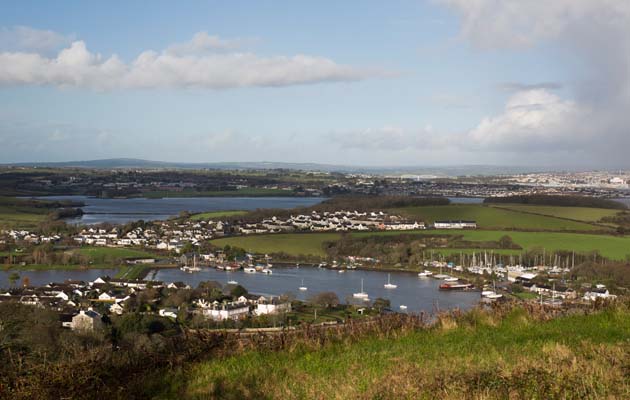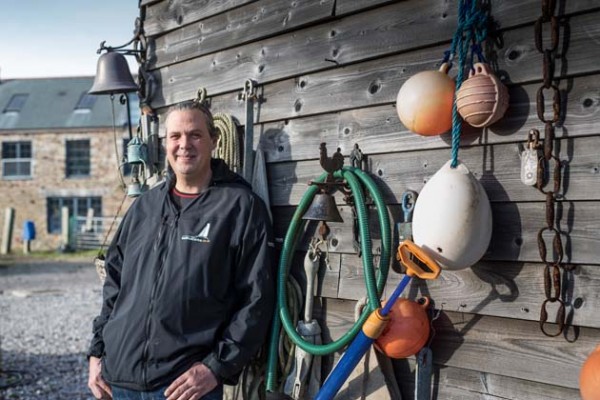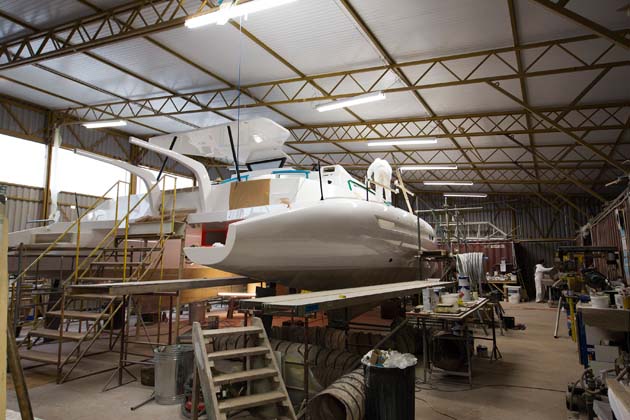Millbrook is a small village at the end of a creek with yards that produce quirky designs, from traditional craft to composite multis. Toby Hodges was intrigued to find it was here where the cutting edge Dazcat 1495 was built
The estuaries and rivers that probe into the green hills of Devon and Cornwall’s south coast feature anchorages with a natural charm that is hard to match. Most of these inlets have a strong maritime history and once had active boatyards. Over time many of these yards have had to close as demand waned and skills ceased to be passed down through the generations. Not so at Millbrook.
Millbrook Lake is the first inlet on the Cornish side of the Tamar, a drying creek, and you may even fail to notice its mouth from Plymouth’s bustling waterfront opposite.

Nowadays Millbrook is home to many fascinating boatbuilding projects, which range from the purest form of traditional wooden boat craftsmanship to high-tech multihulls. Since Pat Patterson sailed to Millbrook in 1968 and started designing and building cats here, it is also home to the UK’s largest multihull boatyard and is the birthplace of a multitude of British cruising cat designs from Patterson, Richard Woods and Darren Newton.
I visited the creek to test the latest and largest model yet to launch from the Dazcat brand, the Dazcat 1495 which we tested in the March issue, and was amazed by the thriving projects underway on this short stretch of foreshore.
Builder of Impossible Dream
Darren Newton – the ‘Daz’ behind Dazcat – has been building catamarans at Millbrook’s Foss Quay for over 20 years. Notable examples are Mike Browne’s Impossible Dream, aboard which disabled sailor Geoff Holt famously crossed the Atlantic unassisted, and the radical joystick-operated Rapier 550, launched in 2014.

Over the last decade, Newton’s Multimarine company has gradually acquired much of the hard standing and foreshore area of Foss Quay. This now includes the Multihull Centre – the brokerage and storage site created by Pat Patterson and the only UK yard completely dedicated to multihulls – plus the 16th Century tidal mill at the head of the creek.
Multimarine itself is a real, honest, rather unkempt yard. Numerous 40ft containers form the workshops and even bases of the sheds, their stark corrugated sides hiding a composite craftsmanship within that is first class.
If you want to learn about multihulls, Millbrook is the place to go. In wintertime, it is like a catamaran museum, with up to 80 cats on the hard standing. Newton pointed out, it seemed, virtually every British catamaran design I had heard of, from local models like Patterson’s Heavenly and Summer Twins, Ocean Winds and Twins, and Woods designs, to Prouts and James Wharram cats, plus some ‘foreigners’ such as Catanas and Fontaine Pajots.
Putting the dazzle into cats
On the wall of Darren Newton’s neat Portakabin office is a picture that contrasts with the series of bright modern designs Dazcat now produces. It is a fading photograph of a Formula 28, the first boat Newton designed. He rented a pig shed near Totnes “for £5 a week” and built his first boat over two years. ‘Daz’s cat’ got abbreviated, and the first Dazcat launched in 1989.
The boat was seriously damaged by storms while in Millbay marina that winter, so Newton shortened it to a 26-footer and added transom-hung rudders. Success immediately followed in the Mocra multihull racing class.
Newton competed in the Round the Island Race in 1991 and won it in a time of 3h 55m. “I said that we would win it or lose the boat,” Newton recalls. “It was blowing a Force 7 and we carried full main and kite to average 24 knots between the Needles and St Cats.”
Newton set up a polytunnel in his parent’s back garden in Modbury, Devon to build another Formula 26. Meanwhile, the landlord of the Ellis Boatyard in Millbrook offered to rent out his yard. Although carrying a large overdraft at the time, Newton jumped at the chance, inviting friends to come and work at Millbrook. When he returned from racing the newly launched Dazcat 26 Clarks Active Air in the 1994 Transatlantic Race (winning their class), Newton was surprised to find he had six employees.

The second Dazcat 1495 Apollo in build
The one-off Dazcats built in the mid to late 1990s earned a good reputation in offshore races, particularly the Round Britain Race. Multimarine was established in 1999 to build other designers’ boats.
Over the past five years, together with his business partner, Simon Baker, Newton has gradually scaled up the production side of the yard. This, together with other one-off projects, has ensured continued vitality in Millbrook.
Millbrook showpieces
Multihull enthusiasts will know Millbrook for the bulk of British cats from Patterson and Woods that have launched from its shores. More recently there have been some other notable one-off projects. Talented local shipwright Chris Rees built the lugger Spirit of Mystery for Pete Goss, plus the 65ft replica of the 1776 lugger Grayhound – both from locally felled trees.
The 60ft Impossible Dream, designed by Nic Bailey and launched by Multimarine in 2002, was the catamaran aboard which Geoff Holt OBE set a record for the first quadriplegic unassisted transatlantic crossing.

Darren Newton has long recognised the benefits of multihulls for wheelchair users. In the mid-1990s he built the trimaran Paradox for Alan Grace, a paraplegic sailor. And Newton’s latest commission is for another wheelchair user, for whom he has adapted the Dazcat 1195 design. The mast is positioned right aft to fly furling foresails only, promising ultra-simple sail-handling and a 1,000nm motoring range.




